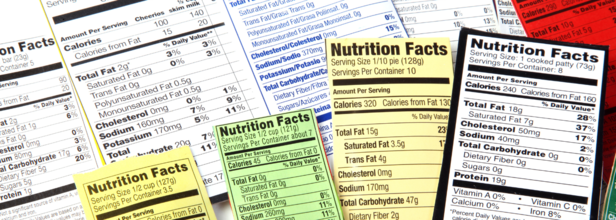- Health Conditions A-Z
- Health & Wellness
- Nutrition
- Fitness
- Health News
- Ayurveda
- Videos
- Medicine A-Z
- Parenting
FDA Wants Nutrition Labels Of Saturated Fat, Sodium, And Added Sugar On Food Packaging

The United States Food and Drug Administration announced on Tuesday and in the coming next few years, food manufacturers have to put nutritional labels on the front of packaged foods. This proposal by FDA comes in the content of chronic diseases and the need for combating the same. The front-of-package labels are required for "most packaged foods", said the announcement.
Nutrition Info Box
The labels will be called the "Nutrition box info", which would show customers whether products have low, medium, or high levels of saturated fat, sodium, and added sugars.
Saturated Fat
They are solid at room temperature and found in animal products like pork, milk, and cheese. The American Heart Association (AHA) recommends limited saturated fats to less than 6% of total calories. It is one of the unhealthy fats and too much of it in your diet could lead to heart diseases and other health problems.
Sodium
As per FDA, diets higher in sodium are associated with an increased risk of developing high blood pressure, which is also the major cause of stroke and heart attack. Sodium attracts water, which increases the volume of blood in your body and can lead to high blood pressure, and damage your heart, kidneys, brain and eyes.
Added Sugars
Added sugars are added to foods and drink during processing or preparation and they do not occur naturally. They add calories but little nutrition. As per the Centers for Disease Control and Prevention (CDC), added sugars can contribute to health problems such as weight gain, obesity, type 2 diabetes, and heart diseases.
What happens with the proposal?
If the proposal is approved, food manufacturers who make $10 million or more in annual food sales will have three years to add the labels to their packaging. While businesses with less than $10 million in annual food sales will have four years to comply.
Chronic Diseases
FDA said that saturated fat, sodium, and added sugars have been "directly linked with chronic diseases". The FDA highlights that chronic diseases like heart disease, cancer, and diabetes are the leading causes of disability and death in the U.S., with 60% of Americans living with at least one chronic condition. These illnesses also account for much of the $4.5 trillion spent annually on healthcare in the country.
According to FDA, a major factor contributing to the issue is also the overcompensation of saturated fat, sodium, and added sugar. There are many store-brought foods that are highly processed and also contain excessive amounts of these ingredients. In 2023, the FDA also conducted a study that involved 10,000 adults to evaluate how different types of nutritional labels influence consumer choices.
The research revealed that a black-and-white nutrition label displaying the percent daily value was the most effective in helping people select healthier options.
This is why the Nutritional Info Box will also come in the same color. If reports are to be believed, it will soon become part of the White House National Strategy on Hunger, Nutrition and Health to reduce diet-related diseases by 2030.
Winter Cold And Congestion? Here’s How A Hot Toddy Can Help

Credits: Canva
Folklore has long suggested that a hot toddy, the warm alcoholic drink made with hot water, lemon juice, honey, and spirits such as whiskey, rum, or brandy, can ease a sore throat or help clear congestion caused by a winter cold. Many people swear by it. But what exactly is a hot toddy, and how does it work when you are dealing with cold and congestion?
What Is A Hot Toddy?
Hot toddy is a popular winter drink, especially during colder months. It is a traditional mix of whiskey or rum, hot water, honey, lemon, and warming spices like cinnamon or cloves. The drink helps warm the body, offers comfort in chilly weather, and may support the body during seasonal illnesses such as colds and flu.
Each ingredient plays a role. Honey is known for its natural antibacterial properties, while lemon provides vitamin C to support immune health. Alcohol acts as a mild vasodilator, which helps improve blood flow, and spices aid digestion while easing congestion. Together, these elements make hot toddy a soothing, natural option for winter discomfort.
That said, moderation is key. One serving, or at most two, especially in the evening, may help with sleep, stress, congestion, sore throat, and general discomfort. Below are some potential health benefits of drinking a hot toddy during winter.
Hot Toddy Health Benefits
1. Soothes Sore Throat and Cough
A hot toddy can feel deeply comforting when your throat is irritated during winter. The heat from the water, combined with honey, helps coat the throat and calm inflamed tissues. This can ease irritation caused by dry air or colds. Honey’s antibacterial qualities support healing, while lemon adds vitamin C to help the immune system. A small amount of whiskey or rum may further relax throat muscles, making coughing and swallowing less uncomfortable.
2. Boosts Immunity During Winter
Winter often brings frequent infections, but a hot toddy may help strengthen the body’s natural defences. Vitamin C from lemon supports white blood cells that fight viruses common in colder months. Honey provides antioxidants and enzymes that assist overall immunity. The warmth of the drink increases circulation, helping immune cells move efficiently through the body. Spices such as cinnamon or ginger offer anti-inflammatory benefits that may reduce the risk of infection. Having this drink before bedtime can support the body during seasonal changes.
3. Relieves Congestion and Clears Sinuses
Blocked noses are a common winter complaint, often caused by cold air outside and dry heating indoors. The steam from a hot toddy can help loosen mucus in the sinuses and nasal passages. Lemon’s acidity may help break down phlegm, while alcohol slightly widens blood vessels, which can ease congestion. Slowly inhaling the vapour can help open airways and make breathing more comfortable.
4. Warms You Inside Out
Few things fight winter chills better than a warm drink. Hot toddy raises your core temperature, helping warmth spread through the body. Alcohol encourages better circulation, especially to hands and feet that often feel cold. Ingredients like ginger or cloves add a warming effect by gently increasing metabolic heat.
5. Relaxation and Better Sleep
Winter stress, shorter days, and busy schedules can interfere with sleep. A hot toddy in moderation may help the body relax. Alcohol has a calming effect that can slow mental activity and ease restlessness. Honey may help stabilise blood sugar levels overnight, reducing sleep interruptions. The warmth of the drink also signals the body to wind down and prepare for rest.
Can A Hot Toddy Help With A Cold?
There is no cure for the common cold. Most people manage symptoms through home remedies and over-the-counter medicines. Honey is known for its anti-inflammatory effects, and lemon contains antioxidants that support health. However, no scientific studies have directly proven that hot toddies treat colds.
That said, according to Medical News Today, many people believe that a hot toddy can help ease common cold symptoms, including:
- runny nose
- sore throat
- sneezing
- fever
- body aches
- headache
- fatigue
- cough
While it may not cure a cold, a hot toddy can offer comfort and temporary relief during the winter months when used responsibly.
When Coffee Turned Toxic: The Mystery Jaundice Case No Test Could Explain

Credits: iStock
A young man walked into a hospital with two worrying symptoms that had been bothering him for nearly two weeks. His eyes had turned yellow and his urine had grown unusually dark. These are classic warning signs of jaundice, often linked to liver trouble. Naturally, doctors began running tests.
He had already consulted two doctors before reaching out to The Liver Doc, @theliverdr on Instagram, Dr Cyriac Abby Phillips, hepatologist and clinician scientist, who shared this case study on his Instagram post. Blood tests for common causes of acute hepatitis came back negative. Viral markers were clear. Autoimmune conditions were ruled out. Scan after scan showed nothing definitive. Despite extensive investigations, no one could pinpoint the cause.
When he finally The LiverDoc, even his team found themselves stuck.
A Simple Question Changed Everything
As Dr Philips later wrote in his post, the breakthrough came not from a scan or a lab report, but from a conversation. Almost as a last attempt, the team asked the patient a simple question. Had he changed anything recently in his diet?
The young man paused and then mentioned something that seemed harmless at first. He had started drinking coffee a few weeks earlier.
Coffee? That did not raise alarms immediately. As Dr Philips often points out in his posts, regular coffee is actually known to be protective for the liver. It does not cause jaundice.
But then came the detail that made everyone stop. It was not regular coffee. It was “Chinese coffee” given to him by his roommate.
Not All Coffee Is Coffee
When asked to show the product, the patient shared a photo. Dr Philips, a coffee lover himself, immediately realized this was not coffee at all. It was Chinese herbal coffee, specifically a product labelled as Jasmine Black Coffee, sold as an instant powder drink.
After what Dr Philips described as a “whodunit-style investigation,” the cause finally became clear. The young man had been drinking this herbal coffee for a week, about two to three cups a day, just before his symptoms began. Along with jaundice, he had severe itching of his hands and feet, another sign of liver injury.
The Hidden Danger Behind “Jasmine”
True jasmine plants, commonly used for flavoring teas, are generally safe in small amounts. But as Dr Philips explained in his post, several toxic plants are also casually referred to as “jasmine.”
These include Night-blooming jasmine, Yellow jessamine, and Star jasmine, all of which can cause serious toxicity. Some contain compounds that behave like vitamin D in the body, leading to dangerous calcium overload. This can damage not just the liver, but also the heart and kidneys.
Why Herbal Coffees Are Risky
The biggest concern, according to Dr Philips, is that these herbal coffees and teas are largely unregulated. There is no reliable way for consumers to know which plant species or plant parts are actually used. Health claims are made freely, but safety testing is often missing.
His advice is clear and direct. Stay away from advertised “exotic herbal drinks.” They are neither proven safe nor proven beneficial, and the risk to your liver may be far greater than you realize.
Could This Popular Drink Really Help Lower Blood Pressure And Protect Your Heart?

Credits: Canva
A simple drink costing just 22p per serving could benefit your heart. Recent research suggests that orange juice may help reduce blood pressure and inflammation, which are two major risk factors for cardiovascular disease.
Cardiovascular Disease: A Growing Concern In The UK
Cardiovascular disease remains a leading health concern in the UK, responsible for roughly a quarter of all deaths each year. This umbrella term covers conditions affecting the heart and blood vessels, including coronary artery disease, stroke, heart failure, and irregular heart rhythms.
While medications exist to manage these conditions, health authorities recommend lifestyle adjustments as well. Among these, dietary changes are crucial, particularly reducing foods high in saturated fats.
Orange Juice Shows Promise for Heart Health
New research from the University of São Paulo in Brazil, published in Molecular Nutrition and Food Research, has revealed that orange juice can influence genes linked to high blood pressure and inflammation. These are key contributors to heart attacks, strokes, and heart failure.
Inflammation can damage blood vessels, constrict arteries, and promote plaque buildup. Orange juice was also shown to enhance genes involved in fat metabolism, supporting better processing and storage of fats in the body.
Layanne Nascimento Fraga, the study’s lead author, told Medical News Today: “We used a transcriptomic approach to observe the effects of orange juice on the entire metabolic system, allowing us to see multiple pathways working together. We found improvements in key cardiometabolic markers, including blood pressure, inflammation, oxidative stress, and lipid metabolism.”
The study identified 1,705 genes affected by orange juice, with 98% being downregulated, highlighting its broad impact on cardiovascular health.
Personalised Benefits and Nutrigenomics
The researchers noted that orange juice’s effects can vary based on an individual’s body weight. This provides insights for tailored dietary recommendations, particularly regarding flavonoid-rich foods like citrus. At the time of reporting, a litre of orange juice from Tesco cost 89p, making a 250ml serving roughly 22p.
Supporting Evidence from Other Studies
This is not the first time orange juice has been linked to heart health. A 2023 study in Lipids in Health and Disease found that consuming two glasses (480ml) daily for at least a year led to significantly lower cholesterol levels in participants aged 18–66.
A meta-analysis reviewing nine studies also suggested that orange juice may improve levels of “bad” LDL cholesterol, though effects on total cholesterol and “good” HDL cholesterol were not significant.
A 2021 study in the European Journal of Nutrition further showed that hesperidin-enriched orange juice could reduce systolic blood pressure and pulse pressure, offering a potential tool for managing pre- and stage-1 hypertension.
It is important to remember that orange juice contains roughly 24 grams of sugar per serving, which should be considered when incorporating it into a daily diet, especially for those monitoring sugar intake.
© 2024 Bennett, Coleman & Company Limited

